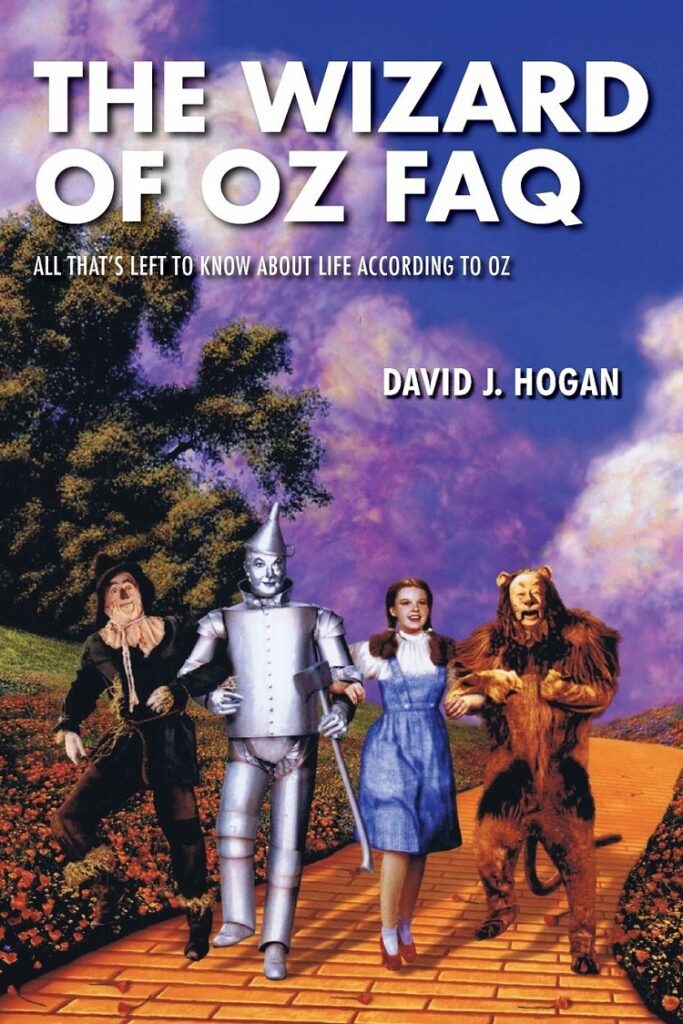
The Wizard of Oz is an enduring and endearing classic. Who hasn’t seen it, perhaps even multiple times? It made a star out of cultural icon Judy Garland and has held up remarkably well over the years since its 1939 release, enchanting generations of young and old alike. There have been stories over the years about what went on behind-the-scenes of making the film. The most familiar factoids center around Buddy Ebsen, who was originally cast as the Tin Woodman, but had such a terrible reaction to the silver make-up that he had to quit. Another popular story concerned the ribald antics of “The Munchkins” during production, which were even featured in a 1981 film, Under the Rainbow, starring Chevy Chase and Carrie Fisher.
One might think that a new book about the making of the film, The Wizard of Oz FAQ, might just be a rehash of such stories, peppered with a few photos, but it is far more than that. An impressive tome, running over 400 pages, The Wizard of Oz FAQ is a detailed, analytic look at the making of the film in all of its aspects – from the writing of the original source material, by Frank L. Baum, to selecting the actors, to the production of the film and beyond.
Author David J. Hogan is no stranger to writing about film. His other titles include Three Stooges FAQ, Science Fiction America: Essays on SF Cinema, and Dark Romance: Sexuality in the Horror Film. He is also straight-forward in how encyclopedic he wants this book to be, subtitling it “All That’s Left to Know About Life According to Oz” – and he may be right. Hogan starts off not with the making of the film, but the formation of the studio that produced it, MGM, providing background stories about Louis B. Mayer and the birth of Hollywood and proceeds from there. It is this attention to detail that makes The Wizard of Oz FAQ such a fascinating read.
One can read The Wizard of Oz FAQ straight through, and watch the step-by-step formation of an American cinema classic unfold. But after doing so, I have found that it is equally possible to go back and skip around and read certain sections that might pique one’s interest, like actor biographies or the different directors who also came and went during production. One passage, in a section covering the actor Jack Haley (the Tin Woodman) was especially interesting. Hogan manages to show how thoughtful the casting was, but also how proficient were the actors of the time, who knew just what was wanted to create their classic characters:
Haley had read Baum’s Oz books to his son, Jack Haley Jr., so he had more than a passing acquaintance with the world of Oz before he was cast in the movie. The actor’s ability to project warmth suited the Tin Woodman nicely, but Haley saw nothing particularly remarkable about the part. Like others in the cast, Haley had experience that let him understand how to “sell” a character, so director Victor Fleming went along when Haley suggested that he and Ray Bolger, Bert Lahr, and Frank Morgan adopt what Haley called “storyteller” voices – an occasionally breathy quality that expressed a childlike sense of wonder. The technique was used subtly during the Kansas sequences and became pronounced once the actors were in Oz. Because of the actors’ ability to “shade” their emotional pitch, the vocal effect isn’t overdone and registers almost subliminally as one more marker telling the audience that Oz is a place unlike any other. The actors understood this perfectly, and Ray Bolger later recalled, “I tried to get a sound in my voice that was complete wonderment, because I [the Scarecrow] was new, so newly made.”
Now who wouldn’t want to go back and watch the film again, after reading that, to look for their technique, and add another level of enjoyment to the viewing of the film? Author Hogan doesn’t stop just there, but covers all aspects of Oz, from Garland’s recording of “Over the Rainbow” to costumes to casting, to fan reaction to the film – and yes, even includes stories about Ebsen and the Munchkins. There are fun behind-the-scenes photos, too. Lovers of the classic film will love The Wizard of Oz FAQ and Hogan’s in-depth history of early Hollywood and one of its most beloved films.